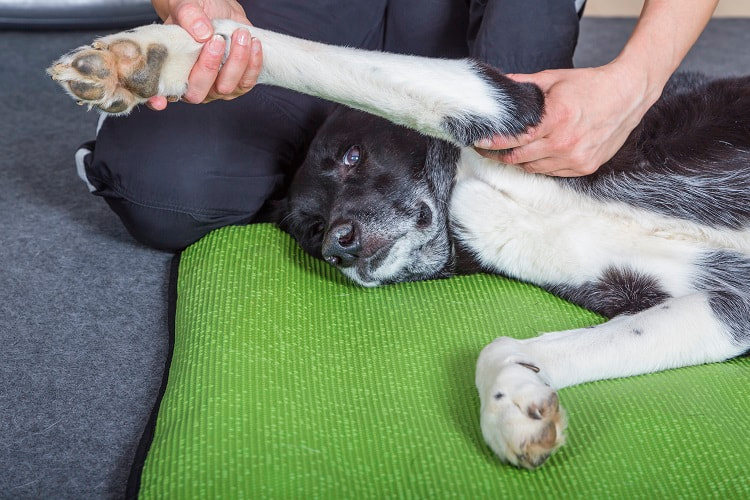|
For animal owners
Arthritis is a common infliction in dogs that can be debilitating. Although it is mainly older dogs that suffer, chronic pain in younger dogs can also be caused by arthritis. Despite arthritis being extremely commonplace, there is still a lot that that dog owners do not know about the condition. Since it can cause your dog extreme pain, it is important to learn as much as you can about it. Even if your dog has not been diagnosed, it is also vital that you know the signs. In our guide for pet owners, we discuss in more detail what arthritis is, what the symptoms are, what causes it, and what treatments are available. What is arthritis? Arthritis occurs when there is damage to the cartilage between joints. The function of cartilage is to absorb the shock from movement and to support the bones by providing protection. As the cartilage is damaged and starts to thin, the bones begin to touch each other when the joint is moved. This causes inflammation, which is painful to the area and over time can end up damaging the bones . To begin with, the joints will become stiff and if the condition worsens, the limbs can stop moving completely. There is not simply one type of arthritis, there are some variations. Osteoarthritis Also known as degenerative joint disease, this is the most common form of arthritis in dogs and occurs when there is consistent wear and tear on a joint over time. The more strain that is put on the joint, the more likely it is that osteoarthritis will occur at some point in the future. It is due to this strain that dogs that are overweight and older are at more risk. Degenerative arthritis can also be caused by a joint injury or a condition such as hip or elbow dysplasia. Immune-mediated arthritis Also known as rheumatoid arthritis, this is common in smaller dogs such as “toy” breeds and is caused by an overreaction of the dog’s own immune system. Whilst the immune system usually detects antigens inside the body and creates antibodies to combat them, in rheumatoid arthritis, the immune system mistakes its own protein as an antigen and therefore starts fighting itself. Septic arthritis Found most commonly in male dogs that have weakened immune systems or have previously been diagnosed with diabetes. This type of arthritis is usually caused by bacteria that spreads within the bloodstream and reaches the joints. How to spot signs and symptoms Unfortunately, when arthritis starts it can sometimes be difficult to spot. As the condition is progressing, you will notice the symptoms getting worse over time. Since older dogs are often more likely to suffer from arthritis, the symptoms can often be confused with old age. You may notice that your dog is becoming slower in how they move, slower getting up after exercise and a reduced ability to jump. You may also notice an altered gait. By this, we mean that your dog is trying to put less weight on the affected joints and therefore their movements will be different. If this is not spotted quickly, your dog can end up putting additional strain on their other limbs which can make the overall condition worse. You also may notice that your dog starts to struggle to climb stairs. They may also lick or chew the affected joints and they can often end up sleeping more and more. Diagnosis and Treatments Your first port of call should always be your Vet so that an accurate diagnosis can be made. Your Vet may also suggest x-rays to determine the extent of the arthritis. Following diagnosis, your Veterinary Surgeon will discuss the various options availalbe to you including the use of medication to help reduce pain and inflammation. Whilst there is, unfortunately, no cure, there are several treatments that have been proven to help reduce the pain and improve your dog’s overall wellbeing and happiness. Therefore, the sooner the condition is caught, the better. Diet Dogs that are severely overweight are more at risk of arthritis. Therefore, ensuring your dog has a healthy diet can help them avoid the condition. If your dog already has arthritis, having a healthy diet is vital to help them keep the condition under control. Having excess weight will cause additional strain on the joints. Your Vet will be able to recommend a diet plan with you. Physiotherapy Keeping active is vital to help keep your dog healthy. However, if your dog has an injury or already has arthritis there may be specific exercises that can be done to help keep the pain to a minimum and help overall mobility. Speak to a qualified Pet Physiotherapist who will be able to create a tailored routine for your dog. Laser Therapy Many dogs suffering from arthritis can benefit from laser therapy. This process is non-invasive and painless. Using lasers to stimulate blood flow, the process can help reduce inflammation, release endorphins, and therefore help keep the pain under control. Over time it can greatly improve arthritic conditions. Hydrotherapy Hydrotherapy is great for overall fitness but can also be extremely beneficial for dogs with arthritis. As the exercises do not involve any weight being applied to the joints, they can help increase movement without being too painful. Benefits from hydrotherapy can be increased when this therapy is combined with a physiotherapy plan. Supplements There is a range of nutritional supplements available that can help improve how your dog is feeling. Glucosamine is a commonly prescribed supplement, as it is the substance naturally found in the body that helps repair cartilage and tissue. The amount of glucosamine naturally produced reduces over time as your dog ages, so supplementing it can help boost your dog’s natural healing ability. It also has an anti-inflammatory effect which in turn can reduce pain. Make them comfy There are also things you can do straight away at home to help. Ensure your dog always has access to a comfy bed that is warm. Cold, hard surfaces can aggravate arthritis symptoms. Slipping on wooden floors can aggravate painful arthritic joints. Have a look to see if there are areas in your house where this commonly occurs (e.g. hall, bottom of the stairs). Use of runners, non-slip rugs etc, can reduce the risk of your dog slipping.
As we have discussed, arthritis is extremely common, and whilst there is no cure, there is a myriad of treatment options available. If you believe your dog is showing signs of arthritis, ensure you visit a Vet as soon as you can. They will then be able to work with you to create an effective treatment plan. They will also be able to refer you to trained professionals who can provide laser therapy, physiotherapy, and more to help enhance your dog’s quality of life.
0 Comments
Your comment will be posted after it is approved.
Leave a Reply. |
AuthorNAVP Archives
June 2024
Categories
All
|
The Association |
Services |
|


 RSS Feed
RSS Feed